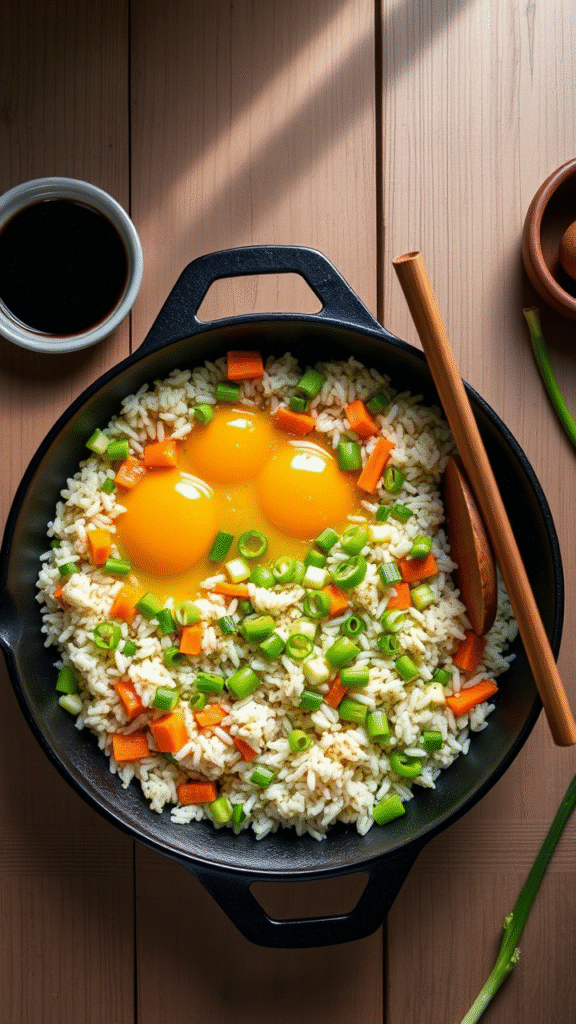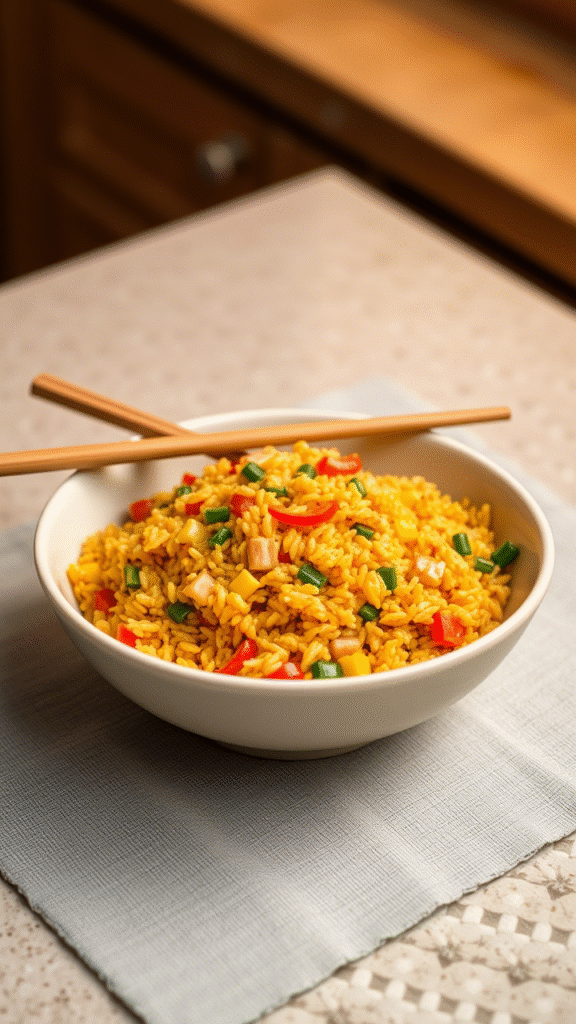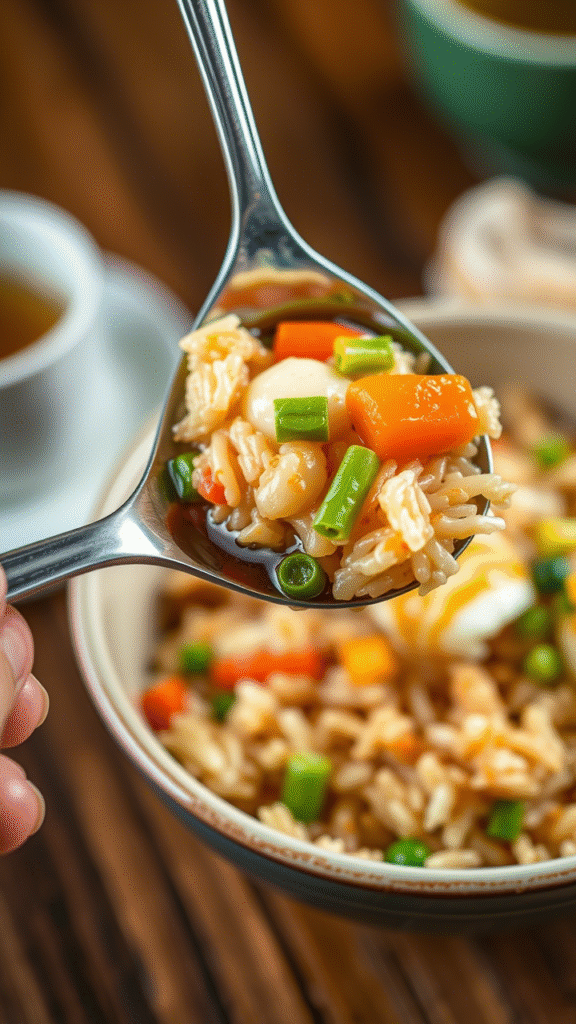The first time I made egg fried rice properly—really properly—was at 2 a.m. after a double shift on the line, with nothing in the fridge but some cold rice, three sad spring onions, and eggs. I didn’t expect much. But what I got was magic in a pan—smoky, savory, steaming comfort in every forkful. It taught me that simple doesn’t mean basic. It means sharp. It means intentional.
This is egg fried rice. It’s a five-ingredient wonder and a lifetime technique. It can be street food in Bangkok or the “please feed me” cry of a homesick student. It’s been made a thousand ways, but there’s a right way to make it sing. That’s what we’re doing here—egg fried rice with clarity, precision, and a touch of flair. Not flashy. Not heavy. Just dead-on delicious.
What Is Egg Fried Rice?

Egg fried rice is a classic dish across many Asian cuisines, particularly Chinese. It’s basically day-old rice stir-fried at high heat with scrambled eggs, aromatics, and seasoning. That’s it on paper. But real ones know—it’s technique that separates clumpy blandness from that perfectly balanced, smoky, golden-flecked bowl of bliss.
And why’s it special? Because it’s fast, satisfying, adaptable, and sneakily sophisticated. It turns leftovers into glory. It teaches heat control, timing, and restraint. That’s the core of good cooking.
Ingredients & Substitutions
Here’s the foundational list—what you actually need. Everything else is a bonus.
- 2 cups cold cooked jasmine rice
→ Must be cold. Fresh rice turns mushy. Jasmine adds fragrance, but any long-grain rice works. Basmati if you must, but rinse it real good. - 2 large eggs
→ Fresh, room-temp eggs whip up fluffier and cook more evenly. Organic’s great, but any decent egg will do. - 2 tablespoons neutral oil (e.g. canola, peanut, or sunflower)
→ You want high smoke point. No olive oil. Peanut oil adds a lovely roasted note. - 2-3 spring onions (scallions), finely sliced
→ Use the white and green parts. White goes in early, green at the end. Sub with shallots in a pinch, but different vibe. - 1–1.5 tablespoons soy sauce
→ Light soy, ideally. Not dark—it muddies the flavor and color. Add a few drops of fish sauce for depth if you’re into that kinda thing.
Optional Add-Ins (for flair or diet needs):
- Tamari – gluten-free soy sauce alt.
- Toasted sesame oil – drizzle at the end, don’t cook with it.
- Chili crisp or sambal oelek – for heat.
- Frozen peas or diced carrots – don’t overload. Keep it rice-first.
- Mushrooms, tofu, leftover pork belly – go wild but stay intentional.
Pro tip: Don’t go pantry-raiding just to toss more in. Every ingredient should earn its spot.
Step-by-Step Instructions (with Real Tips)
Step 1: Prep everything first.
This is fast cooking. No time to slice onions mid-sauté. Beat your eggs lightly, have your rice ready (break up any clumps with wet hands), oil measured, and sauces on deck.
Step 2: Heat your pan until it’s borderline angry.
Use a wok if you’ve got one. If not, a carbon steel or cast iron skillet works. Medium-high to high heat. Let the oil shimmer. Not smoke. Shimmer.
Step 3: Cook the eggs—fast and loose.
Pour beaten eggs into the hot oil. Let them set just a little, then scramble gently. Don’t overcook. You want soft curds, not rubbery bits. Remove from pan once just set. They’ll keep cooking off-heat.
Step 4: Sauté the whites of the scallions.
Little oil, maybe a touch more if pan’s dry. 20 seconds max. Just to take the bite off.
Step 5: Add the rice.
Here’s where most folks mess up. You gotta fry the rice. Toss it, press it down, let it sear a bit, then toss again. You’re looking for a tiny bit of crisp on the edges. That’s the good stuff.
Step 6: Return eggs to pan. Toss with rice.
Break up any big egg clumps. Everything should be cozy, but not mashed together. Like a well-dressed salad.
Step 7: Season with soy sauce and green onions.
Drizzle soy from the edge, not the middle. Toss. Taste. Add a dash more if needed. Finish with green scallion tops and, if you’re extra, a whisper of sesame oil.
Cooking Techniques & Science

Why day-old rice? Because moisture is the enemy of good fried rice. Fresh rice has too much surface starch and water. Cold rice firms up, dries out, and separates into clean grains. That’s what you want.
High heat is non-negotiable. You’re not reheating—you’re frying. Without high heat, the rice steams. High heat gives you that faint smoky flavor the Cantonese call wok hei—“breath of the wok.” It’s magic, and you only get it from a screaming hot pan and fast hands.
Oil matters. Neutral oils don’t fight with the aromatics. Peanut oil? Slight nuttiness, great aroma. Sesame oil? Only use at the end—burns easily and turns bitter fast.
Eggs go first, come out, go back in. That’s the choreography. Cook ’em separately for texture. Dumping raw eggs onto rice turns the whole thing into weird eggy porridge.
A metal spatula is your best friend. It scrapes and tosses without mercy. Silicone’s too soft. Wood’s too clumsy. This is a dance, not a hike.
Serving & Pairing Suggestions

Serve hot—piping hot. Straight from wok to bowl. No garnish needed, but if you wanna be cheeky: a fried egg on top, chili oil, or a few cucumber slices on the side.
Pairs beautifully with:
- Cold beer – Tsingtao or Sapporo, crisp and clean.
- Cucumber salad – vinegar-based, sharp and refreshing.
- Miso soup – light, brothy contrast.
- Quick-pickled radish or kimchi – if you’re in a fusion mood.
Plating tip: Pack it into a bowl, then flip it out onto a plate for that perfect dome. It’s silly but oddly satisfying.
Conclusion: Why This Recipe Matters
This isn’t just something you make because you’re tired and broke—though it’ll have your back in those times, no doubt. This is a foundational dish. A canvas. A muscle memory builder. It teaches you to control heat, judge timing, respect ingredients. It’s the kinda dish you think you know… until you really learn it.
Keep it humble. Let the rice shine. That’s egg fried rice done right.
FAQs
1. Can I use fresh rice instead of day-old rice?
You can, but it won’t be as good. Spread it on a tray and chill for an hour at least to dry it out a bit if you’re in a rush.
2. How do I keep my rice from clumping?
Use cold rice and break it up with wet hands or a fork before it hits the pan. A bit of oil on your fingers helps too.
3. Is a wok really necessary?
Nope. A wide non-stick or cast iron pan works. But a seasoned wok gives you better heat and that “wok hei” magic.
4. Can I add meat or vegetables?
Absolutely. Just cook them separately and fold in at the end. Keep the main structure simple—rice, egg, soy. Let the add-ins support, not dominate.
5. Why are my eggs rubbery?
Too much heat or overcooking. Scramble them gently and remove early. They’ll finish cooking when mixed back into the hot rice.

Food lover, recipe creator & the heart behind NoshCrafters.com. Olivia shares mouthwatering, easy-to-make dishes that turn everyday meals into unforgettable bites. When she’s not experimenting in the kitchen, she’s busy plating up inspiration for home cooks everywhere.